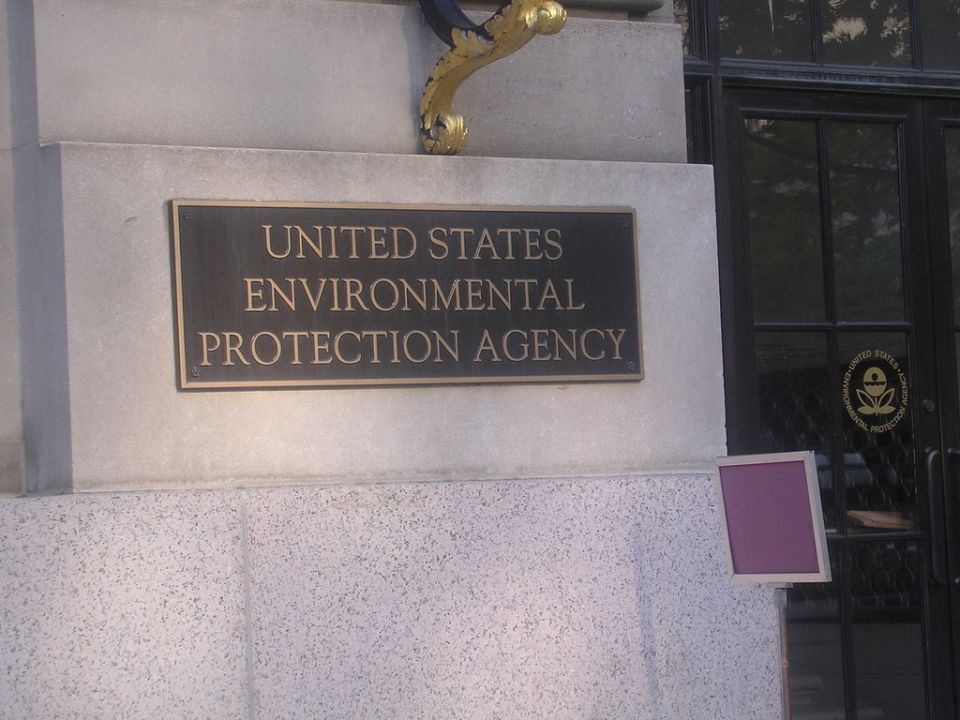A new report paints the Environmental Protection Agency under Scott Pruitt’s leadership in a particularly bad light.
Among the allegations from the report, which relies on anonymous sources: that Pruitt, despite his role as EPA head, has almost never met with environmental groups, and is, in fact, hamstringing his own agency’s law enforcement and regional offices; that Pruitt has banned employees from taking pen and paper into meetings out of fear of information being leaked; and that Pruitt’s office suppressed plans for an agency Earth Day picnic because it seemed too combative.
“Beneath the veneer of Pruitt’s public statements and appearances, I think there’s a lot of dysfunction,” says Christopher Sellers, a history professor at Stony Brook University who interviewed 32 current and former EPA employees for the report, which was released publicly today by the Environmental Data & Governance Initiative, an activist group of university professors. EDGI organized shortly after President Donald Trump’s election in a response to what founders saw as anti-science sentiment in the administration.
The new EDGI report indicates there’s widespread demoralization and dissent within the EPA. That’s not surprising. Trump has long called for policies that are sure to be unpopular at the agency. While running for office, he vowed to shutter the agency. Since then, he has blamed environmental regulation for killing jobs; worked to repeal EPA rules; and, in his proposed budget, called for a 31 percent cut to the agency’s funding, which would likely eliminate thousands of jobs. Pruitt, meanwhile, has denied the reality of climate change, then later said he thought the Earth is warming, but wasn’t sure how much human activity had to do with it. What the new report offers are fresh details about Pruitt’s internal decisions and how they may already be affecting the agency’s work.
For the report, Sellers worked with seven other academics to interview 10 current and 37 former employees of the EPA between December of 2016 and May of this year. They recruited their sources through EPA alumni groups and by asking people they were already in contact with to refer them to others. They did not reveal their sources’ identities to Pacific Standard. Requests for comment from the EPA were not returned.
EDGI’s work paints a picture of an imbalanced agency that favors certain industries and constituents over others and is stymied by distrust between its head and his staff. Indeed, some doubt whether Pruitt wants the EPA to work at all. “I think the plan is to get rid of EPA,” one employee told the EDGI interviewers. “I think this is just phase one.”
Only Some Stakeholders
Pruitt hasn’t been around for his staff, interviewees told EDGI. Few of the interviewees had seen him in the Washington, D.C., office. Instead, the sources said Pruitt seems to travel frequently and to pay attention to a select group of stakeholders: He’s gone to meet the governors of Western states, farmers, and coal miners, for example. He decorated headquarters with posters showing him shaking hands with miners. In late March, Trump visited the EPA headquarters to sign an executive order rewriting the Obama administration’s Clean Power Plan and starting the process of lifting a moratorium on coal leasing on federal land. He did so with Pruitt at his side and several coal miners surrounding him. “You know what it says, right?” Trump told the miners. “You’re going back to work.”
“Beneath the veneer of Pruitt’s public statements and appearances, I think there’s a lot of dysfunction.”
Meanwhile, EPA workers told EDGI interviewers that they had never heard of Pruitt meeting with environmental groups. Other news reports suggest such meetings may indeed be rare. Pruitt’s calendar for February 21st through March 31st, obtained by E&E News using a Freedom of Information Act request, shows Pruitt talked with car, coal, oil, gas, and utility company executives, as well as politicians. He never had appointments with environmentalists in that time period, although an agency press release says he met with the Nature Conservancy and Audubon Society in Dallas, Texas, on April 22nd, Earth Day.
Security Concerns
Pruitt seems unusually worried about his safety, EDGI’s interviewees reported. He has 24-hour protection and employs armed members of the environmental crimes unit to cover him. Previously, EPA administrators typically only had security during their workday and commutes and didn’t tap criminal investigators to cover them unless they were traveling out of town, E&E News reports.
Having Pruitt-protection duty hampers agents’ ability to pursue criminal pollution cases, Michael Hubbard, a retired special agent for the the EPA, told E&E News. But Pruitt may be facing “legitimate and valid threats” that would make him decide to up his security, Hubbard added. Pruitt has faced a lot of resistance since his nomination. Protesters rallied during his confirmation vote and visits to Chicago and Dallas.
‘Near Paralysis’ of Work
Pruitt’s office has asked to have final say in lower-level work than its predecessor did, according to EDGI’s interviewees. The result? A slowdown in productivity as requests pile up, unanswered, in Washington. “We’ve hit a period of near paralysis,” one interviewee said. “The administrator and his immediate [circle] have sent the message that they want to approve regulatory enforcement efforts, permits, agreement, etc., no matter how routine. A significant amount of time is spent briefing issues with little resolution and without opportunities to interact with the new decision-makers.”
Even when Pruitt hasn’t passed specific policies, some employees are reportedly hindering their own environment-policing work in anticipation of what the Trump administration might want. “People in the region will start to anticipate how things are going to go and so they’ll take a certain directive and they’ll make it even more stringent,” one interviewee said. “I find that is already happening here in my region and the people I work with.” (The EPA splits the U.S. into 10 regions, with an EPA office for each.)

(Photo: Stony Brook University)
Another interviewee had a different opinion: “If you think for one minute they’re going to stop their passion, stop being an environmentalist, retire because they can afford it or because of their conscience, or go away—you’re wrong. That’s not who EPA is.”
It’s too soon to say what effect Pruitt and the Trump administration will have on the EPA’s overall productivity. EDGI suggests the fate of the agency under President Ronald Reagan may offer a hint. Like Reagan’s, Trump and Pruitt’s approach to the EPA is driven by their belief that the agency claims too much authority and power. Both Reagan and Trump proposed unprecedentedly deep cuts to the agency’s budget and used executive orders to limit agencies’ authority across government. EDGI’s interviewees considered the Reagan administration to be the closest historical precedent to the present day.
In two years, the Reagan administration cut the EPA’s budget by 21 percent and its staff by 26 percent. During that time, the agency referred 69 percent fewer civil cases to the Department of Justice while regional EPA offices referred 79 percent fewer new civil cases to the Washington, D.C., headquarters, according to A Season of Spoils: The Reagan Administration’s Attack on the Environment by Jonathan Lash, Katherine Gillman, and David Sheridan.
Then, in 1983, EPA Administrator Anne Gorsuch was forced to resign. Environmentalists and Congressional Democrats had complained that she levied too light of penalties for polluters and that, under her leadership, the EPA was too slow to clean up toxic waste dumps. The House of Representatives subpoenaed her for documents about her pollution clean-up efforts. When she refused, on Reagan’s orders, the House held her in contempt, which was the beginning of her downfall in government. Since then—until Trump and Pruitt, that is—no president or EPA administrator has been as openly hostile to the agency’s mission and culture, EDGI’s interviewees say.
Whether Pruitt is in danger of a similar unraveling remains to be seen. Several things put him in a stronger position than Gorsuch was. During Gorsuch’s tenure, anti-environmentalism was not as central to the Republican Party’s philosophy as it is today, High Country News reports. In addition, Democrats controlled the House and moderate Republicans, the Senate. Now Republicans control both branches of Congress.
Mutual Distrust
Several other, less verifiable claims in the report speak to intense mutual distrust between the EPA head and his employees.
Two of EDGI’s interviewees—one admitting they heard this information “third- or fourth-hand”—said employees weren’t allowed to take notes during meetings with Pruitt. “Everything is just verbal. If it’s just verbal, then there’s no record that you can get a FOIA to see what happened,” one interviewee said. Some said his office squelched plans for an Earth Day picnic for employees because it would look too much like a protest. One EDGI interviewee interpreted Pruitt’s heightened guard as a sign that “he feels his life is, I guess, at risk because there’s such internal hatred at EPA.”

“This is scary and unfounded,” that interviewee said.
While the culture among workers at the EPA has long been to keep their heads down and work quietly, some are now less circumspect. “I have worked under six administrations with political appointees leading EPA from both parties,” one interviewee said. “This is the first time I remember staff openly dismissing and mocking the environmental policies of an administration and by extension [Pruitt], the individual selected to implement the policies.”
Not all of EDGI’s interviewees feel such rancor about Pruitt’s tenure. Some are seeing their work go forward and don’t think the administration has had a big effect on them, says Sellers, the Stony Brook University historian and EDGI interviewer. But those who work in branches of the agency with a bigger-picture view? “They’re some of the most worried because they see the extent of what’s going on,” he says.
One of the strongest impressions that Sellers’ report leaves is the depth of the divide between much of the EPA’s workforce and its leader. How this friction affects the EPA’s ability to achieve any of its goals, whether they’re Pruitt’s or individual employees’, remains to be seen.





